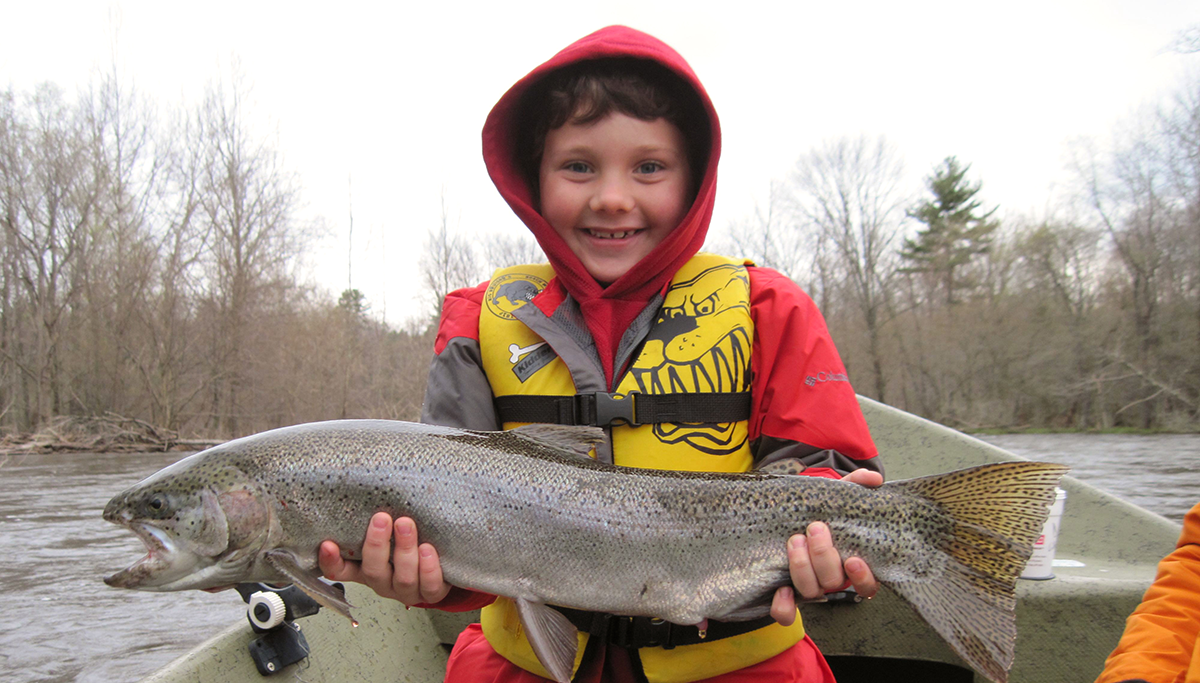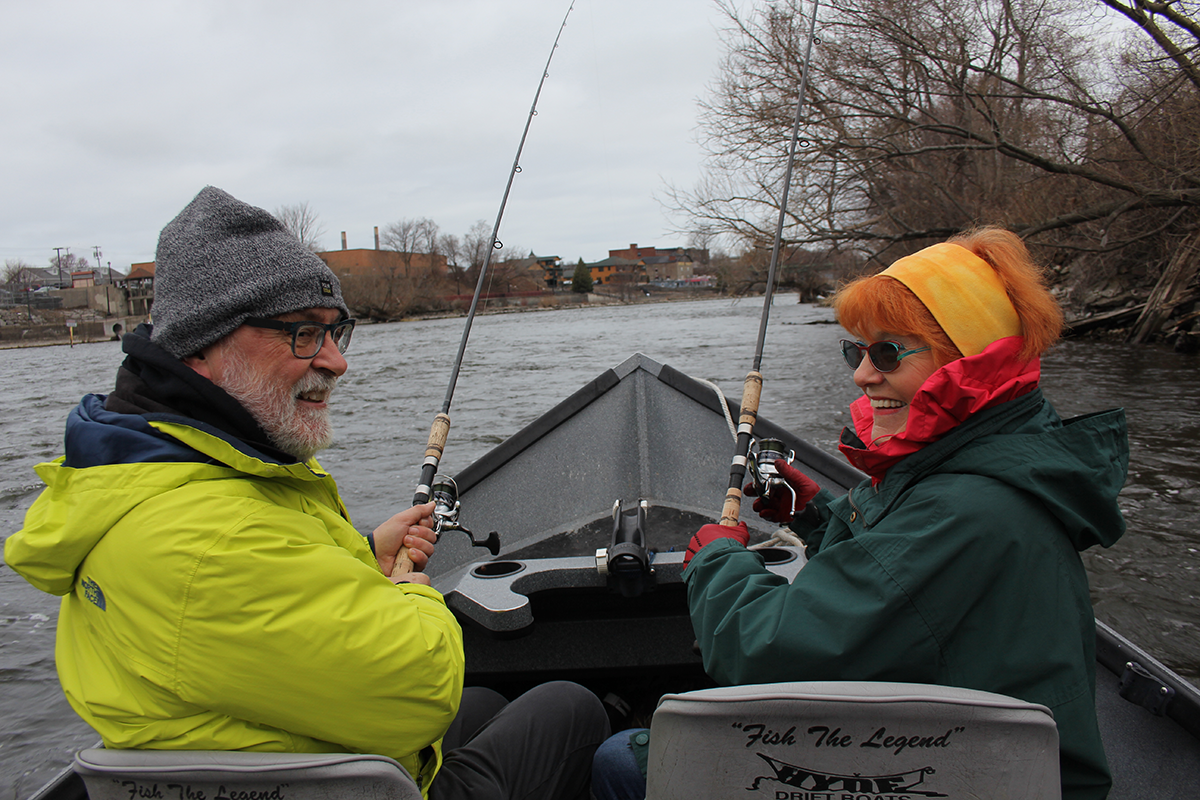
The Curious Trekker
By Peter Johansen
Trout fishing in America
Trout fishing in America Andy Bliss is as encouraging as Oprah. He’s smart like Einstein, patient like Job. Yet even he can’t turn us into fearsome fisher folk.
We’re on the Oswego River, at the southeast corner of Lake Ontario, doing our darndest to land steelhead, a species of migratory rainbow trout. But nothing seems to work. That might have something to do with ineptitude. I’ve fished only once before. My wife, Oxana, is experienced: she’s fished twice, albeit in the Caribbean. And our chattering teeth say this ain’t the Caribbean.
It’s early April, after all, in northern New York State. When we clamber aboard guide Captain Andy’s wind-whipped drift boat at 7:30 a.m., it’s just below freezing. Shivering in every piece of clothing we’ve brought, we anchor near a tree rising from the water. Its roots buffer the river’s current, giving fish security. Andy asks if we’ll need right-handed or left-handed rods. We guess. He then explains how to hold our rods, unlatch the bail arm, let the float drop gently, and allow the current to drag the red float (and bait that will dangle near the riverbed) downstream.
But not so far that we lose sight of the float, for when it dips below the water, we’re likely to have a bite — and that’s when you start reeling-in — before you feel a tug. I’m delighted I don’t have to cast — no flying hooks will lodge into any of us. But I keep losing sight of my float as I look around.

Oswego is a college town, but it’s also the oldest U.S. port city on the Great Lakes. Much of that heritage remains. Close by are an old textile mill, a former flour mill, a railroad trestle. There’s a power plant and a dam, too, with signs that warn us to clear the river whenever a siren wails. But there are also trees spreading over the water, slivers of islands and birds overhead. In any season but this, it would be pretty.
This is urban fishing at its best. The Oswego River is Lake Ontario’s second largest tributary. It lures brown trout, king and coho salmon in autumn, steelhead arrive in late winter. They all come to spawn in water that’s a tad warmer than Lake Ontario. And because there’s only a short distance between the lake and the first dam, fish are concentrated, leading to big catch rates.
It’s often said that Oswego County has the best cold-water fishery in the continental United States. Its eight world records for salmon and trout remain unchallenged. A passel of state records stand as well. Little wonder more than 30,000 out-of-state and international visitors buy fishing licences in Oswego each year.
Back in the 1950s, there wasn’t much of anything here except alewives, a type of herring that overran Lake Ontario after a host of ills — dams, deforestation, pollution, overharvesting, invasive species — wiped out the lake trout and Atlantic salmon that once thrived. The state’s conservation authority opened a fish hatchery at Salmon River in 1980 to stock Lakes Ontario and Erie, plus many of their waterways. These days, the facility places about 12 million trout, salmon and walleye annually. The efforts have paid off. “Today, Ottawa is within four to five hours of one of the most exciting fisheries in the world,” says Fran Verdoliva of the hatchery, which hosts 50,000 visitors a year for tours.
So, we should be getting bites aplenty. After all, Captain Andy started fishing with his grandfather at two years of age, came to Oswego for university because he could fish, and hooked up with an experienced guide “who taught me more than any person has a right to. He knew every pebble in the Oswego River.”
Certified by the Coast Guard, Captain Andy, 39, is now a legend himself. He’s won the Lake Ontario Challenge Cup five times in the past decade, teaches seminars for the Lake Ontario Trout Salmon Association, was profiled on network TV, and is a brand ambassador for several companies, including Pautzke Bait and Michigan Stinger.

He explains that our locally made bait, Trick’em beads, most closely resemble the type of food available in the river. He cautions me to reel in my line when it gets too close to Oxana’s. He ensures that my float doesn’t drift too far. He switches rods. He moves the boat to different spots. None of it works. “It says ‘guide’ on my licence, not ‘God,’” he quips.
He’s certain weather and water flow are to blame for our bad luck. An overnight plunge in temperature is compounded by a quick drop of water level, thanks to the dams. “It’s like flicking a light switch,” the guide explains. “Rapid drops in water level or temperature affect fish big time. They get lethargic. They won’t come to the bait. The bait has to come to them.”
He seems downright despondent when we get nary a nibble. “This is what keeps me awake at night, worrying that someone has booked a trip on a day that just doesn’t work out. I’m sitting at home every night looking on the computer for rain, temperature, everything. But that’s fishing.”
We aren’t disappointed, though — at least not much. As Captain Andy puts it just before we bid goodbye: “They say God doesn’t subtract for days spent fishing.”






